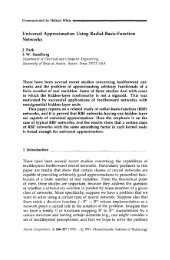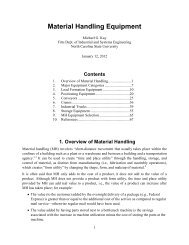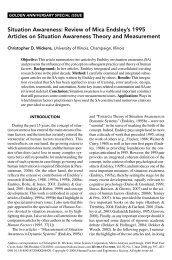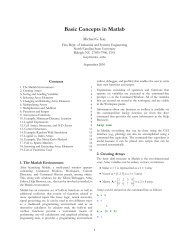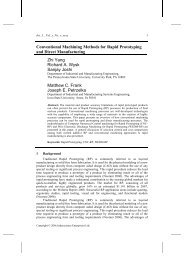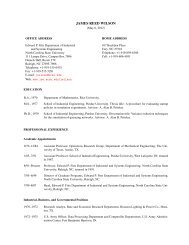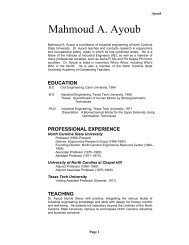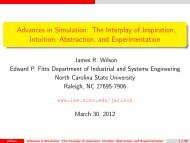Multiple Resources and Mental Workload - ResearchGate
Multiple Resources and Mental Workload - ResearchGate
Multiple Resources and Mental Workload - ResearchGate
You also want an ePaper? Increase the reach of your titles
YUMPU automatically turns print PDFs into web optimized ePapers that Google loves.
MULTIPLE RESOURCES AND MENTAL WORKLOAD 451<br />
concurrent task performance of the resource allocation<br />
policy between the tasks, their dem<strong>and</strong> for<br />
limited resources (task difficulty), <strong>and</strong> their dem<strong>and</strong><br />
for common versus distinct resources (e.g.,<br />
resource overlap). After these authors integrated<br />
their theory with my postulation of the identity of<br />
the three (later four) specific resource dimensions,<br />
this one particular version of the multiple resource<br />
model emerged (Wickens, 1980, 1984).<br />
The rationale for defining these four dimensions<br />
is based strongly on the confluence <strong>and</strong> joint satisfaction<br />
of two criteria. First, the four dimensions<br />
defining the model should have neurophysiological<br />
plausibility, in the sense that the dichotomies<br />
have parallels in brain anatomy. In the 3-D + 1<br />
model, they certainly do: (a) Perceptual-cognitive<br />
activity is associated with neural activity posterior<br />
to the central sulcis of the brain, whereas motor<br />
<strong>and</strong> action-oriented activity is anterior. (b) Awellestablished<br />
line of research associates the processing<br />
of spatial <strong>and</strong> verbal material, respectively,<br />
with the right <strong>and</strong> left cerebral hemispheres of<br />
most individuals. Recently work by Just <strong>and</strong> colleagues<br />
(Just et al., 2001; Just, Carpenter, & Miyaki,<br />
2003) has directly associated activity in these areas,<br />
as assessed by functional magnetic resonance<br />
imaging (fMRI) analysis, with dual-task processing<br />
<strong>and</strong> resource dem<strong>and</strong>. (c) Auditory <strong>and</strong> visual<br />
processes are distinctly associated with auditory<br />
<strong>and</strong> visual cortices, respectively. (d) Focal <strong>and</strong> ambient<br />
vision are supported by ventral <strong>and</strong> dorsal<br />
visual pathways, respectively (Previc, 1998).<br />
The second criterion emerged from my human<br />
factors orientation. I felt it important that the<br />
dimensions of the model coincide with relatively<br />
straightforward decisions that a designer could<br />
make in configuring a task or work space to support<br />
multitask activities: Should one use keyboard<br />
or voice? Spoken words, tones, or text? Graphs or<br />
digits? Can one ask people to control while engaged<br />
in visual search or memory rehearsal? These<br />
two criteria, neurophysiological plausibility <strong>and</strong><br />
design decisions, appeared to be fairly well satisfied<br />
in the proposed cube model. Furthermore,<br />
with a few qualifications described at the end of<br />
this article, the model has appeared to st<strong>and</strong> the test<br />
of time in its ability to account for three decades<br />
of dual-task research <strong>and</strong> to support design decisions<br />
(see Wickens, 2002, for a recent summary).<br />
Alternative multiple resource models have been<br />
proposed. Two have been grounded most prominently<br />
in the hemispheric laterality framework<br />
described earlier. Polson <strong>and</strong> Friedman (1988)<br />
focused exclusively on this dimension, whereas<br />
Boles (Boles, 2002; Boles, Bursk, Phillips, &<br />
Perdelwitz, 2007; Boles & Law, 1998), using factor<br />
analysis, has further differentiated auditory <strong>and</strong><br />
visual processing within each hemisphere into<br />
subprocesses such as spatial positional, spatial<br />
quantitative, auditory linguistic, <strong>and</strong> auditory<br />
emotional resources. In this manner, 14 separate<br />
perceptual resources emerge (<strong>and</strong> 17 overall). This<br />
structure also has been evaluated in dual-task paradigms,<br />
revealing that task pairs with a greater<br />
degree of resource overlap suffer greater dualtask<br />
decrements. With the proliferation of more<br />
resources, it becomes more difficult to precisely<br />
associate each with brain locations (<strong>and</strong> therefore<br />
gain full neurophysiological plausibility; Wickens,<br />
2007), but fMRI technology offers promise that<br />
such association might be forthcoming.<br />
Both EPIC (Kieras, 2007; Meyer & Kieras,<br />
1997) <strong>and</strong> a model of threaded cognition (Salvucci<br />
& Taatgen, 2008) invoke multiple resource constructs<br />
within perceptual modalities to account for<br />
dual-task interference patterns. Finally, singlechannel<br />
bottleneck theory (Pashler, 1998) represents<br />
a version of multiple resource theory<br />
(although not cast in those terms), based primarily<br />
on the stage dimension. Here response selection<br />
depends on a very limited supply of resources,<br />
forcing essentially on sequential processing with<br />
high time dem<strong>and</strong> tasks, whereas perceptualcognitive<br />
resources are limited but more available.<br />
As noted by Wickens <strong>and</strong> Holl<strong>and</strong>s (2000), such<br />
multiple resource assumptions are quite consistent<br />
with data from the double-stimulation paradigm<br />
(Pashler, 1989, 1998).<br />
A COMPUTATIONAL MODEL<br />
We have recently developed a relatively simple<br />
computational model of multiple resources, following<br />
a more elaborate version described <strong>and</strong> validated<br />
in Sarno <strong>and</strong> Wickens (1995). This simple<br />
model (Horrey & Wickens, 2003; Wickens, 2002,<br />
2005; Wickens, Dixon, & Ambinder, 2006) predicts<br />
total interference between a time-shared pair<br />
of tasks to be the sum of two components, a dem<strong>and</strong><br />
component (resource dem<strong>and</strong>) <strong>and</strong> a multiple<br />
resource conflict component (degree to which<br />
overlapping resources are required). Each of these<br />
components can range in ordinal values from 0 to<br />
4, providing a simple, intuitive, <strong>and</strong> bounded scale.



